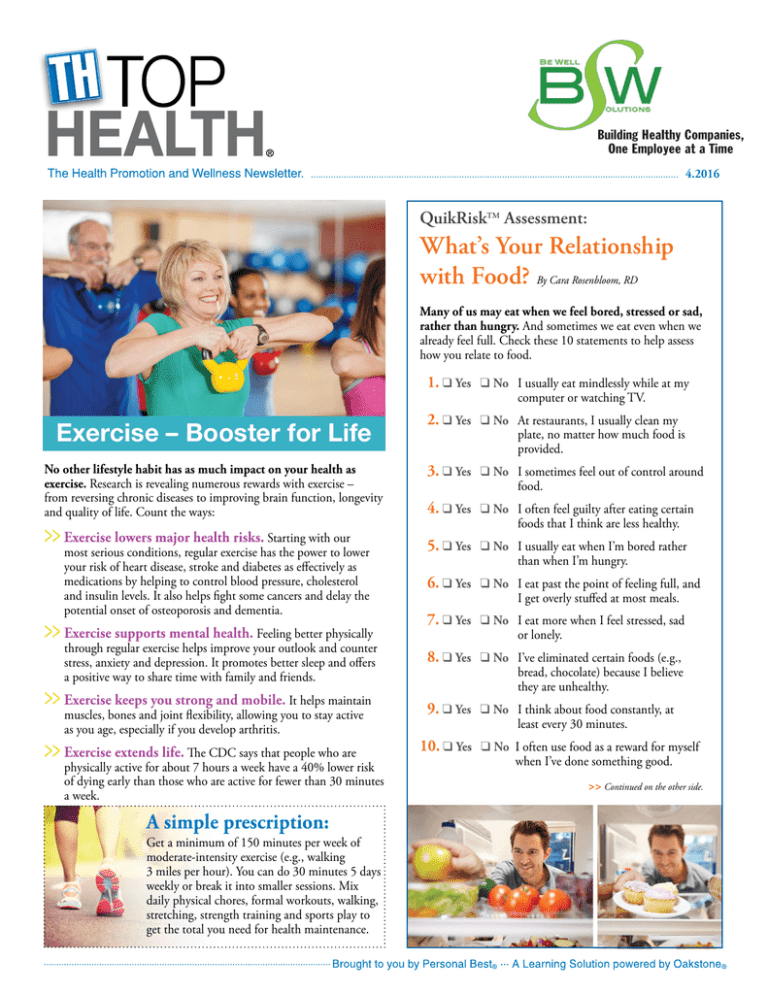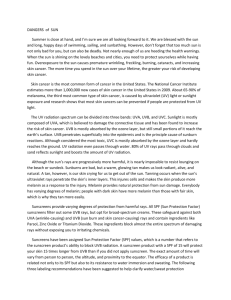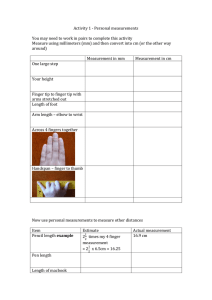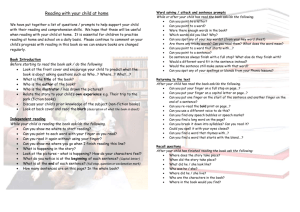What’s Your Relationship with Food? QuikRisk
advertisement

4.2016 QuikRiskTM Assessment: What’s Your Relationship with Food? By Cara Rosenbloom, RD Many of us may eat when we feel bored, stressed or sad, rather than hungry. And sometimes we eat even when we already feel full. Check these 10 statements to help assess how you relate to food. 1. ❑ Yes ❑ No I usually eat mindlessly while at my computer or watching TV. Exercise – Booster for Life No other lifestyle habit has as much impact on your health as exercise. Research is revealing numerous rewards with exercise – from reversing chronic diseases to improving brain function, longevity and quality of life. Count the ways: >> Exercise lowers major health risks. Starting with our most serious conditions, regular exercise has the power to lower your risk of heart disease, stroke and diabetes as effectively as medications by helping to control blood pressure, cholesterol and insulin levels. It also helps fight some cancers and delay the potential onset of osteoporosis and dementia. >> Exercise supports mental health. Feeling better physically through regular exercise helps improve your outlook and counter stress, anxiety and depression. It promotes better sleep and offers a positive way to share time with family and friends. >> Exercise keeps you strong and mobile. It helps maintain muscles, bones and joint flexibility, allowing you to stay active as you age, especially if you develop arthritis. >> Exercise extends life. The CDC says that people who are physically active for about 7 hours a week have a 40% lower risk of dying early than those who are active for fewer than 30 minutes a week. A simple prescription: Get a minimum of 150 minutes per week of moderate-intensity exercise (e.g., walking 3 miles per hour). You can do 30 minutes 5 days weekly or break it into smaller sessions. Mix daily physical chores, formal workouts, walking, stretching, strength training and sports play to get the total you need for health maintenance. 2. ❑ Yes ❑ No At restaurants, I usually clean my plate, no matter how much food is provided. 3. ❑ Yes ❑ No I sometimes feel out of control around food. 4. ❑ Yes ❑ No I often feel guilty after eating certain foods that I think are less healthy. 5. ❑ Yes ❑ No I usually eat when I’m bored rather than when I’m hungry. 6. ❑ Yes ❑ No I eat past the point of feeling full, and I get overly stuffed at most meals. 7. ❑ Yes ❑ No I eat more when I feel stressed, sad or lonely. 8. ❑ Yes ❑ No I’ve eliminated certain foods (e.g., bread, chocolate) because I believe they are unhealthy. 9. ❑ Yes ❑ No I think about food constantly, at least every 30 minutes. 10. ❑ Yes ❑ No I often use food as a reward for myself when I’ve done something good. >> Continued on the other side. Q: What is trigger finger? A: Trigger finger is a condition that forces the finger to lock in a bent position. The bent finger can make a snapping or clicking sound when it suddenly breaks free and straightens. Other symptoms include finger stiffness and pain or a tender lump at the base of the finger. The condition usually occurs in a thumb, middle or ring finger and results from chronic inflammation and narrowing of the tendon sheath. Ask your health care provider to evaluate possible symptoms; seek immediate medical care if a finger becomes red, hot or inflamed. Trigger finger may result from prolonged irritation of the finger tendon, often due to activities with repetitive gripping motions such as assembling parts, woodworking or sewing. Women are at increased risk for trigger finger as are people with diabetes or rheumatoid arthritis. – Elizabeth Smoots, MD, FAAFP “Living a healthy lifestyle will only deprive you of poor health, lethargy, and fat.” – Jill Johnson April is Alcohol Awareness Month. Alcohol: What You Need to Know CDC data show a 37% increase in alcohol-related deaths in the U.S. since 2002. When deaths resulting from drunk driving as well as homicides and various personal injuries related to alcohol are added, alcohol use leads to nearly 90,000 lost lives per year. Health risks: Heavy drinking can lead to alcoholism, chronic health conditions, obesity and stroke. It raises the risk of cancers of the liver, breast, colon, mouth, esophagus and larynx. Any amount of alcohol may be risky in certain people under certain circumstances. For light drinkers, alcohol’s health effects are less clear. Research suggests moderate alcohol consumption (1 drink a day for women or 2 a day for men) may protect heart health. Keep in mind that beyond moderate use alcohol causes cardiovascular problems. And we have more positive ways to protect our health than drinking. If you’re concerned about your drinking habit, confide in your health care provider, who can help you understand alcohol’s negative health effects. Sunscreen: The Real Cover-Up The labels on sunscreens and any products containing sunscreen ingredients (e.g., makeup, moisturizers and lip balm) now list more information to ensure the products are effective when used properly. The American Academy of Dermatology recommends you look for 3 key ingredients when shopping. 1. Sun Protection Factor (more commonly known as SPF) – While sunscreen products cannot filter out 100% of the sun’s rays, various SPF levels can significantly filter out UVB rays, which cause sunburns. SPF 15 filters 93% of the sun’s UVB rays. SPF 30 filters 97% of the sun’s UVB rays. SPF 50 filters 98% of the sun’s UVB rays. 2. Broad-spectrum – This means the product is backed by testing to help protect against both harmful UVB (burning) rays and UVA (skin aging) rays. The combination can protect your skin from sunburn, skin cancer and early skin aging (premature age spots, wrinkles and sagging skin). 3. Water-resistant – Products using this label must specify how long (either 40 or 80 minutes) the sunscreen is effective while swimming or sweating (backed by testing). These claims are no longer used: waterproof, sweatproof and sunblock. Use a broad-spectrum sunscreen with an SPF of at least 30. Be sure to reapply it at least every 2 hours and after swimming or sweating. Cover up and seek shade to stay safe. QuikRiskTM Assessment: >> Continued from the other side. How did you do? If you checked yes for just 1 or 2 statements, you’re on a good path towards healthy eating. You generally eat when you are hungry, stop when you feel full, and understand moderation. If you checked yes for 3 to 6 statements, try to work on healthy eating awareness. Remind yourself that eating is about filling a physical hunger, not an emotional one. Then enjoy every bite and stop when you’re full. If you checked yes for more than 6 statements, you may be using food to fill an emotional need instead of a physiological one. Talk to your health care provider about how to identify what triggers your emotional eating and what can help get you back on track. Smart Moves toolkit is at www.personalbest.com/extras/16V4tools. 4.2016 TopHealth® is published to provide readers with the information and the motivation needed to achieve and maintain a healthier lifestyle. The content herein is in no way intended to serve as a substitute for professional advice. Executive Editor: Susan Cottman. Medical Editor: Zorba Paster, M.D. Sources available on request. © 2016 Ebix Inc. DBA Oakstone Publishing, LLC. All rights reserved. Unauthorized reproduction in any form of any part of this publication is a violation of federal copyright law and is strictly prohibited. Personal Best® is a registered trademark of Oakstone Publishing, LLC. 2700 Corporate Drive, Suite 100, Birmingham, AL 35242 • 800-871-9525 • fax 205-437-3084 • e-mail: editor@personalbest.com • website: www.personalbest.com. GET WELL, STAY WELL NEWSLETTER YOUR GUIDE TO HEALTHY LIVING Are you looking to fit more exercise into your day? Many of us have good intentions of exercising before or after work, but life often gets in the way. At Be Well Solutions, we try to fit in a few exercises during our breaks to help us stay fit. Try the exercises in this month’s newsletter next time you have a few minutes. They are simple enough for beginners, do not require any equipment and most of them can be done in your work clothes. Bicep Curl Stand with your feet shoulder width apart. With or without weights, keep your elbows close to your torso and rotate the palms of your hands until they are facing forward. Keeping your upper arms stationary, raise your arms until your biceps are contracted and your hands are at shoulder level. Slowly lower back to the starting position and repeat. Push-up Place your hands shoulder width apart on the edge of a table, desk or bench. Walk your feet back to form a 45 degree angle. Your feet should be slightly closer than shoulder width apart. Your body should be in a straight line, maintaining a flat back. Slowly lower your body to approximately 3 inches from the table. Push back up and repeat. Triceps Kickback Bend slightly forward at the hips until your body is at a 45 degree angle to the floor. Hold your upper arms to your sides and bend your elbows so your lower arms are almost perpendicular to the floor. With or without weights or using a resistance band, extend your arms behind you until they are almost parallel to the floor. Slowly pull your arms back to the starting position and repeat. Calf Raises Stand with your feet a comfortable width apart on a step. Hold onto a railing and place your toes and the balls of your feet on the edge of the step. Pull your abdominals in toward your spine and raise your heels a few inches, so that you are standing on your tip toes. Hold the position for a second. Then, lower your heels by bending your ankles until your calves are stretched. Hold the position for a second. Repeat. If you do not have access to a step, you can use these instructions anywhere. Stand with your abdominals pulled in toward your spine. Your feet should be on the floor. Raise your heels a few inches off the ground, so that you are standing on your tip toes. Hold the position for a second. Then, lower your heels back to the ground. Next, raise your toes a few inches off the ground, so that you are standing on your heels. Hold the position for a second before you lower your toes back to the ground. Repeat. Squat Stand with your feet shoulder width apart. Keep your spine straight and align your knees over your feet. Your knees should never pass in front of the toes. Lower your body down, as though you are sitting in a chair as far as you can go while maintaining proper form. Return to the starting position (do not lock your knees) and repeat. Cheesy Black-Eyed Pea Dip Recipe from http://thenutritionadventure.com/2015/01/26/cheesy-black-eyed-pea-dip/ Ingredients Directions 1. 2. 2 (15.5 ounce) cans black-eyed peas, drained and rinsed 1 (10 ounce.) can diced tomatoes with chilies, drained 3/4 cup frozen corn kernels 3/4 cup red bell pepper, diced 1/2 cup white onion, finely diced 2 chipotles in adobo sauce, diced 1 jalapeno, finely diced (remove seeds if you prefer less spicy) 2 garlic cloves, minced 3 ounces pepper jack cheese, grated 3 ounces white cheddar cheese, grated 3. 4. 5. 6. 7. Preheat oven to 350F. Combine all ingredients, except cheese, in a large bowl and mix. Add half of each grated cheese to the mixture and stir. Pour mixture in an 11x7 inch baking disk. Top with remaining cheese. Bake for 20 minutes until cheese is melted. Serve with tortilla chips or use as a taco filling. Nutrition Facts Total Servings - 12 Per 1 serving Calories: 91 / Total Fat: 3.3g / Saturated Fat: 1.8g / Sodium: 163mg / Carbs: 8.8g / Fiber: 2.2g / Protein: 6.4g For more information, contact Be Well Solutions at (888) 935-7378 or info@bewellsolutions.com. ©Copyright Be Well Solutions, 2016 Tips for a Healthy Back Maintain a healthy weight Strengthen your abdominal (core) muscles Lift items properly using your legs Stretch your leg and core muscles Maintain good posture while both sitting and standing For more information, contact Be Well Solutions at (888) WEL-SERV or info@bewellsolutions.com. ©Copyright Be Well Solutions, 2016





